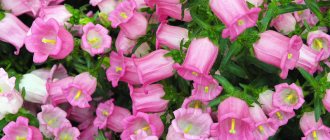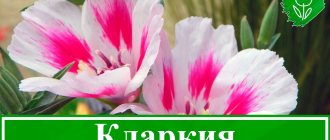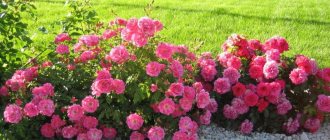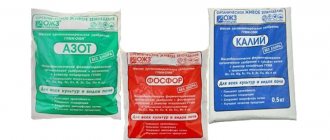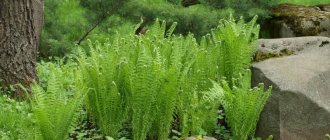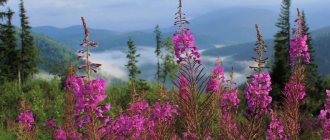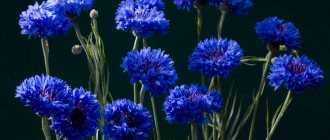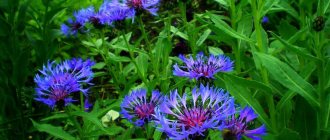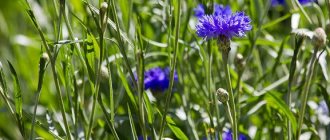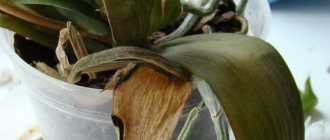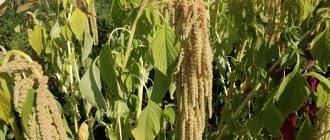History of a flower
The ancient Greeks knew about cornflower. He was mentioned in Meleager's poem "Introduction to the Crown". Cornflower is familiar to many from children's fairy tales and poems. It was first brought to Europe along with rye. The Slavs decorated birthday sheaves with cornflowers and brought them home with songs. A sheaf entwined with cornflowers decorated the front corner of the hut and was a symbol of the harvest. The ornament in the form of ears of rye with cornflowers was popular among needlewomen.
meadow cornflower
There is one story in Russia. When I. Krylov suffered a stroke in 1823, Empress M. F. Romanova sent him a bouquet of flowers and invited him to Pavlovsk to improve his well-being. This touched the fabulist, and later the work “Cornflower” appeared, where he is a fading flower, and the empress is the sun.
Today this plant is used in folk medicine and has an anti-inflammatory and analgesic effect. The infusion is used for heart disease, pain in the head and stomach, and dropsy. An infusion of the plant's baskets can be used for eczema, when bathing a child with diathesis. If the herb is steamed, it can be applied to stretched muscles and tendons. The healing properties are due to the presence of many useful elements in cornflower: manganese, copper, zinc, cobalt, chromium, nickel, potassium, calcium, magnesium, iron.
Important! Not much is known about the medicinal effects of meadow cornflower, so you need to consult a doctor before you start using medications made from it. The use of such drugs is strictly contraindicated for children, pregnant and breastfeeding women.
Meadow cornflower as a honey plant is drought-resistant, therefore it is just suitable for beekeepers during the dry summer period. As for honey productivity, at a favorable time it can produce approximately 110-120 kg of honey from 1 hectare of continuous land. Each flower contains about 5 “portions” of pollen. Bees readily collect it from this flower.
Bee collecting pollen
Materials
To weave cornflowers from beads we will need:
- Beads of four colors No. 10
- Wire with a diameter of 0.3 mm
- Thick wire for the stem
- PVA glue
- Green threads.
To weave cornflowers, you can use beads of dark blue, light blue, sky blue. I wove my beaded cornflower from sky blue beads. A cornflower flower consists of 7 petals intertwined with each other.
Basic botanical characteristics
Cornflower
The stem reaches a height of 1 m, branches in the upper part. At the tops there are inflorescences, which are equipped with a kind of tiled wrapper. The root system is taproot. The leaves are narrow, elongated, green, shiny due to small hairs. The lower leaves are on winged petioles, the middle and upper ones are sessile.
The inflorescences are lilac-colored baskets. There are 2 types of flowers: marginal - funnel-shaped, asexual. They attract pollinating insects to the middle, that is, to tubular flowers (second type), which have both stamens and pistil. The buds open upon contact with a pollinating insect and close until touched again. Belongs to the class Dicotyledons. The fruit is an achene without a tuft.
Description of the variety
It blooms in June-October, achenes ripen from July to October. Can propagate by seeds and vegetatively. If you get into a thicket of cornflowers, the surrounding stems will be waist-deep to a person.
For your information! Several hundred years ago, yellow paint was made from flowers.
Meadow cornflower can be found in many regions of Russia: the European part, Siberia, and the Far East. Grows in meadows, forests, along roads.
Growing
Growing and planting cornflowerCornflower is a magnificent representative of the Asteraceae family, which can become an... not a difficult task. As already mentioned, the wild “blue flower” is mostly a weed, so it does not require painstaking care, has excellent survival rate and can withstand bad weather.
However, if you want to achieve several blooms per season and large inflorescences, you need to know some of the subtleties of planting cornflower. Cornflower is a magnificent member of the Asteraceae family, which can turn id... blue.
First, decide on the planting site, cornflowerCornflower is a magnificent representative of the Asteraceae family, which can become an i... loves sunny and windless areas, because with a lack of sun it stretches upward, its flowers become smaller, and in strong winds it is prone to lodging. Therefore, choose sunny, windless areas.
The only requirement for soil is that the soil is not swampy and fertile. If you plan to plant several different plants to form a composition, then the first rows should belong to cornflowers. Cornflower is a magnificent representative of the Asteraceae family, which can become an ideal... so that the shadow from other plants does not fall on them. The only variety of cornflowerCornflower is a magnificent representative of the Asteraceae family, which can become id... blue, which is able to tolerate shade can be called “cornflowerCornflower is a magnificent representative of the Asteraceae family, which can become id... soft,” but it will also suffer from a lack of sunlight and become smaller year after year.
Planting blue cornflowerCornflower is a magnificent representative of the Asteraceae family, which can become an ideal... you can do it in a row, or in a checkerboard pattern, or in pots, the main thing is to give each specimen plenty of space. If you intend to plant the plant in rows, then follow the “step” of at least 45 cm between flowers.
Proper planting and adherence to agricultural technology will give you a plant that is not only healthy, but also healing. Indeed, on fertile soils and with good care, the plant fully reveals its medicinal potential, accumulates valuable microelements and retains them.
Purchased cornflower seedsCornflower is an excellent representative of the Asteraceae family, which can become id...blue, it is better to sow it in the spring, when the earth has warmed up enough, sowing in beds about 2 cm deep, without thickening. The first shoots will appear within a week; it is better to thin out densely growing seedlings immediately.
If you are planting cornflower seedlings, then plant them in holes no more than 10 cm deep, based on the size and length of the roots (the soil should completely cover them, covering three centimeters of the stem).
Keep the distance between seedlings in increments of 30-40 cm.
Flowers are propagated by seed; after flowering, the cornflower is a magnificent representative of the Asteraceae family, which can become... a seed pod is formed, which, after ripening, will be ready to give you new seeds for planting.
The unpretentiousness of the plant makes it possible for even beginners and inexperienced gardeners to grow it, and its endurance and vitality will save you from painstaking care. Cornflower Cornflower is a magnificent representative of the Asteraceae family, which can become an ideal... blooms for a long time and fits perfectly into any landscape, giving it brightness and airiness. And thanks to its ability to survive, the plant is suitable for absolutely any planting, both in open ground and in greenhouse conditions.
Known varieties and their descriptions
Garden cornflower
There are about 500 varieties of annual and perennial cornflowers in the world. What the flower looks like depends on what variety it belongs to and where it grows.
Annuals:
- blue cornflower is a herbaceous plant that has a stem up to 85 cm long. Inflorescences are baskets of blue or blue flowers;
- Musk cornflower differs from other annuals in its relatively small inflorescence. Its flowers look like small pompoms of various colors.
Musk cornflower
Perennial:
- white - up to 30 cm with double flowers. Listed in the European Red Book;
- Mountain knapweed is the most famous species; it has lanceolate-shaped leaves of a grayish-green color. In the middle the flowers are purple, and then become lighter;
- large-headed - shrub up to 115 cm tall with yellow flowers;
- oriental is a wild plant up to 115 cm high with yellow flowers on long petioles. Known since 1759;
- Russian has ovate baskets, all flowers are light yellow. It will look good in the garden;
- whitened. It got its name due to the color of the leaves. These cornflowers have pink flowers with a white center. Height up to 85 cm;
- rough reaches a height of up to 1 m, flowers are red;
- beautiful cornflower - height up to 25 cm, has round lilac flowers;
- spreading cornflower. The length of the rough and grayish stem with cobwebby hairs is from 20 to 55 cm. It blooms in June-September.
White cornflower
These plants are also divided into low-growing and tall-growing flowers. The first includes beautiful, mountain, white cornflower, and the second includes large-headed, Russian cornflower.
Weeds: benefits
Decorative varieties of common weeds are a new trend in modern landscape design.
There are plants that sometimes cause harm. These are the so-called weed flowers. But we must still recognize their advantages:
• Among the weeds there are beautiful plants: bindweeds, wrapping their delicate long stems around fences and hedges (with snow-white, pink or red flowers).
• There are edible and healthy weeds: quinoa (strawberry spinach or pigweed), nettle (contains many useful minerals and vitamins), etc.
• Many weeds are good as medicines: dandelion, yarrow, St. John's wort, nettle, etc.
• In the garden, weeds attract beneficial insects necessary for pollinating garden plants (clover, dandelion).
• Most weeds can also be used as good fertilizers (alfalfa, nettle, clover, etc.).
• Weeds can signal the gardener about the composition and acidity of the soil in the garden (the composition of the soil can be determined by the prevalence of a particular weed).
Features of collection and storage
Cornflower blue
The inflorescences of meadow cornflower have found application in many areas. And the main thing here is to know how to pick them correctly:
- For medical purposes, buds without internal tubular flowers and roots are collected. You need to take those flowers that have fully bloomed. It is recommended to collect the seeds when the petals wither and the core becomes dark. Collection should be carried out in environmentally friendly places. Therefore, it is not advisable to do this near roads and in other polluted places.
- The baskets are prepared during the entire flowering period, and the roots are collected in late autumn.
- Everything needs to be dried under a canopy in the shade or in well-ventilated areas. In order for the raw material to dry evenly, it needs to be turned over and watched to avoid direct sunlight, because the flowers instantly fade, become white and lose their healing qualities. There are also special drying devices (in which the temperature is from 40 to 50 ° C), which will speed up the process and make drying better.
Important! Dry raw materials retain all their properties. It is stored for no more than 2 years in cloth bags or cardboard boxes.
Despite the fact that cornflower is a weed, it is popular among summer residents, beekeepers, and doctors. It contains many useful elements. Gardeners are attracted by its unpretentiousness (it only needs loosening the soil and regular watering). It is considered a good honey plant, which is important for beekeepers. For medical purposes, it is important to remember that before using medications based on meadow cornflower, you should consult a doctor.
0 0 votes
Article rating
Diseases that meadow cornflower treats
Because the chemical composition of this wild perennial is a very beneficial combination of substances, the plant is often used for medicinal purposes. Traditional medicine has many effective recipes that include meadow cornflower. Professional doctors do not deny the outstanding capabilities of the flower.
Based on this herb, you can prepare various decoctions, infusions, and medicinal teas at home. Components of meadow cornflower are included in many drugs that are officially produced by the pharmaceutical industry.
The main medicinal properties of cornflower are widely used in the treatment of such conditions:
- pathologies of the cardiovascular system;
- kidney diseases;
- disruptions in liver function (cornflower is especially effective for hepatitis);
- intestinal disorders (diarrhea);
- dermatitis and other skin problems;
- menstrual irregularities;
- manifestations of diathesis in infants.
Cornflower helps to cope with the signs of rheumatism and arthritis, eliminates post-traumatic pain from sprains.
